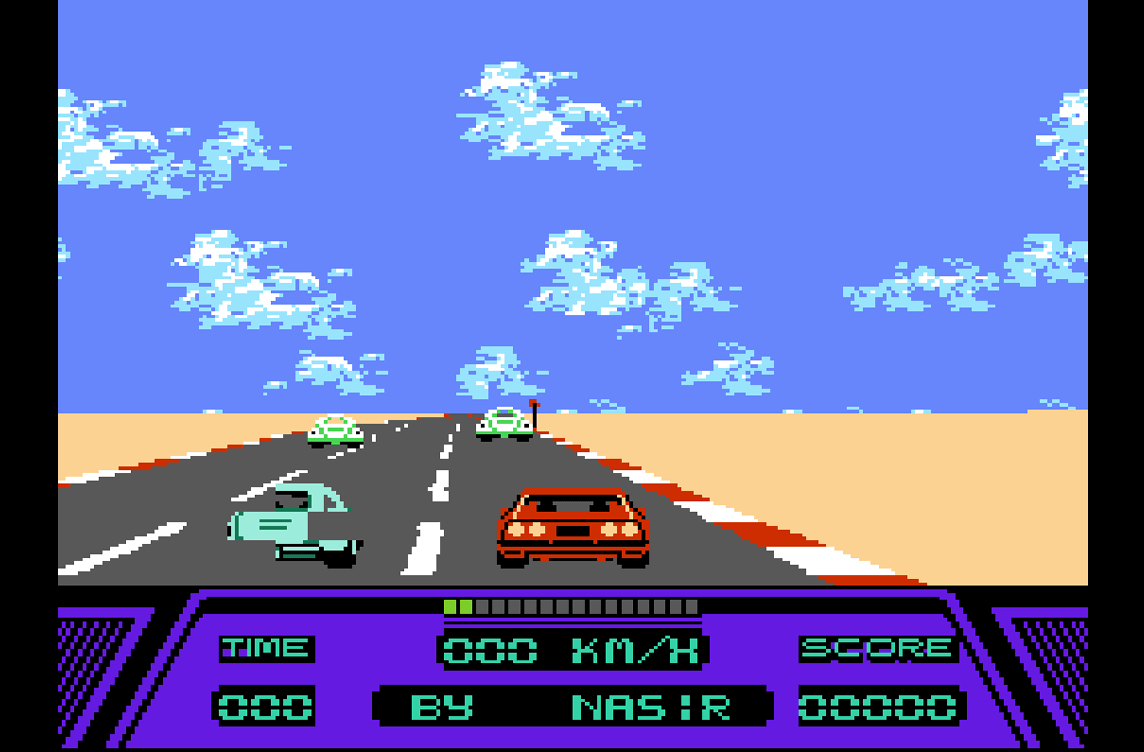Rad Racer, a seminal racing title developed by Square, emerged during the golden age of video games, offering an exhilarating blend of speed, challenge, and nostalgia that continues to captivate gamers across generations. As one delves into the intricacies of this classic NES gem, it becomes evident that Rad Racer represents more than just a racing game—it embodies the spirit of an era, encapsulating the essence of arcade-style excitement within the confines of a home console.
Introduction
Rad Racer burst onto the gaming scene in 1987, igniting a frenzy of excitement among enthusiasts eager to experience the thrill of high-speed racing from the comfort of their living rooms. Developed by Square, a company renowned for its pioneering contributions to the RPG genre, Rad Racer marked the studio’s foray into the realm of arcade-style action, delivering an adrenaline-fueled experience that resonated with players worldwide.
Gameplay and Features
At its core, Rad Racer epitomizes the quintessential arcade racing experience, combining fast-paced gameplay with intuitive controls and dynamic environments. Players are presented with a choice between two iconic vehicles: the Ferrari 328 and an F1 racing machine, each offering a distinct aesthetic appeal. As they navigate through a series of meticulously crafted courses, racers must navigate treacherous turns, dodge obstacles, and outmaneuver rival vehicles to secure victory. The inclusion of checkpoints strategically scattered throughout the tracks adds an element of urgency, challenging players to maintain momentum while racing against the clock.

Despite its simplicity, Rad Racer’s gameplay is deceptively challenging, requiring precision and reflexes to master each course. The absence of divergent roads, a departure from contemporaneous titles like Sega’s OutRun, lends a sense of linearity to the experience, focusing players’ attention on perfecting their driving skills rather than exploring branching pathways. While some may lament the lack of variety in track design, others appreciate the game’s straightforward approach, harkening back to the arcade classics that inspired its creation.
Graphics and Presentation
For an 8-bit title released in the late 1980s, Rad Racer boasts remarkably impressive visuals, leveraging the NES hardware to create vibrant, immersive environments. From the sun-kissed coastlines to the rugged terrain of the Grand Canyon, each backdrop is meticulously rendered, showcasing Square’s commitment to pushing the graphical boundaries of the platform. Parallax scrolling and clever use of color further enhance the sense of depth and immersion, imbuing the game with a level of visual fidelity rarely seen in its contemporaries.
Despite its technical achievements, Rad Racer’s graphical prowess is somewhat overshadowed by its punishing difficulty curve. While seasoned players may relish the challenge of navigating hairpin turns and evading oncoming traffic, newcomers may find themselves frustrated by the game’s unforgiving nature. Nevertheless, those who persevere are rewarded with breathtaking vistas and exhilarating gameplay moments that cement Rad Racer’s status as a visual tour de force on the NES.
3D Mode and Soundtrack
One of Rad Racer’s most intriguing features is its optional 3D mode, a novel concept that sought to emulate the stereoscopic effects of arcade cabinets using specialized glasses. While the implementation may seem primitive by modern standards, it represents a bold experiment in immersive gaming that foreshadowed the rise of virtual reality decades later. Though the effect may appear rudimentary by today’s standards, it serves as a testament to Square’s innovative spirit and willingness to push the boundaries of conventional game design.
Accompanying the adrenaline-fueled gameplay is a dynamic soundtrack composed by the legendary Nobuo Uematsu, best known for his iconic work on the Final Fantasy series. From pulse-pounding synth beats to melodic compositions that evoke a sense of speed and urgency, Uematsu’s score enhances the racing experience, elevating mundane moments into heart-pounding crescendos of excitement. Whether players opt to toggle between available tracks or revel in the ambient sound of the open road, the soundtrack remains an integral part of Rad Racer’s enduring appeal.
Legacy and Historical Significance
Beyond its immediate success, Rad Racer holds a special place in gaming history, serving as a testament to Square’s evolution from a humble developer to an industry powerhouse. The game’s inclusion in prestigious events like the Nintendo World Championships solidified its status as a cultural touchstone, earning it a permanent spot in the annals of gaming lore. Moreover, Rad Racer’s enduring popularity among retro gaming enthusiasts speaks to its timeless appeal, with dedicated fans continuing to celebrate its legacy decades after its initial release.
Conclusion
In conclusion, Rad Racer stands as a testament to the enduring legacy of arcade-style racing games, offering a thrilling blend of speed, challenge, and nostalgia that continues to captivate gamers of all ages. From its groundbreaking visuals and innovative gameplay mechanics to its iconic soundtrack and enduring cultural impact, Rad Racer remains a shining example of Square’s creative vision and enduring influence on the gaming industry.

Play Rad Racer Online Anywhere, Anytime!
Experience the adrenaline-fueled excitement of Rad Racer on our website, accessible across mobile, PC, and tablet platforms. Join the ranks of racing enthusiasts and relive the glory days of arcade-style gaming wherever you go.